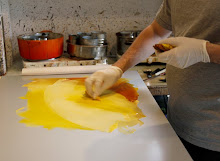
In 1993, I attended Bella Rabinovitch's class on Canadian Contemporary Art at Concordia University in Montréal. This was an intense and challenging class that was extremely formative. Ms. Rabinovitch had acute knowledge of her subject and her analyses were sharp and original. I remember her use of Jerry Seinfeld's sitcom to illustrate in detail the complex notions of post-modernism. She was always providing tons of handouts, and the one that I always kept close by is the CRAP Generator, the Critical Response to the Art Product. This brilliant device is clever, funny and demonstrates that the use of jargon is not necessarily a sign of intelligence…. You can use this appropriately and actually say something or just use it to hide with authority that you don't have anything to say.
The Instant Art Criticism Phrase Generator
Pick at random any four-digit number, such as 8751, then read off phrase #8 of TABLE A, phrase #7 of TABLE B, and so on. The result is a CRAP (Critical Response to the Art Product) sentence. Add a few more four-digit numbers to make a CRAP paragraph. After you have mastered the basic technique, you can realize the full potential of CRAP by arranging the phrases in DACB order, BACD order, or ADCB order. In these advanced configurations, some additional commas may be required. Soon you can produce CRAP critiques as easily and fluently as anyone.
With this device you can write or speak about Art with both authority and confidence. You can amaze and confound both students and general audiences with ease.
TABLE A
- For example
- In this regard
- Similarly
- Academically speaking
- In the broadest perspective
- In particular
- From an intellectual point of view
- As a resultant implication
- Based on current critical thinking
- With respect to the communications objectives
TABLE B
- a portion of the effective visual space
- the positive-negative area counterbalance
- the intrinsic tonal gradations
- the independent functional principles
- the underlying visual thrust
- the spatial configuration concept
- initiation of critical visual thinking
- the characterization of specific ideas
- a constant flow of visual information
- the primary interrelationship between concept and technique
TABLE C
- utilizes and is functionally inter-woven with
- maximizes the probability of response and minimizes the ambiguity required for
- adds explicit aesthetic limits to
- sensitizes the viewer to feel
- necessitates that urgent consideration be given to
- is further expanded, when taking into account
- presents extremely interesting challenges to
- precludes any false manifestations of
- effects a significant reaction to
- adds overriding value constraint to
TABLE D
- the sophisticated visual ideal
- the facing of terrifying reality
- the anticipated emotional and intellectual feelings
- the evolution of subtle reactions
- the total communications rationale
- the philosophy of contemporary visualization
- the active design elements
- the extreme instances of misperception
- the philosophical and theological goal
- the existential principles of visual transfer







No comments:
Post a Comment